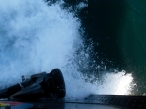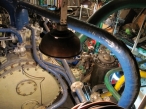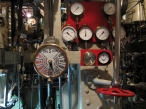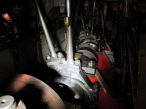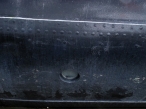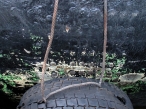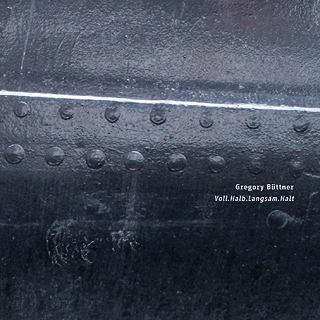
Voll.Halb.Langsam.Halt | Gregory Büttner
Gruen 181 | Audio CD + Digital > [order]
Reviews
„Voll.Halb.Langsam.Halt“ is based on contact mic recordings, which I recorded on an old steamboat, an ice-breaker from the 1930. I had the chance to take a trip on the ship from Rostock to Rügen over the Baltic Sea in 2010. The body of the ship is completely built from metal, so it is a big resonant room which sounds very different on each spot which I put my contact mics on (I used two contact mics, so I could record in stereo). I walked around the ship, placing my mics on different areas of the ship and also directly on parts of the steam engine, which is still fired by coal. For the composition I only used the pure recordings without additional sound manipulations, only juxtapositions, transitions and cuts.
1 Track (35′35″)
CD (300 copies)
Field Recording Series by Gruenrekorder
Germany / 2018 / Gruen 181 / LC 09488 / GEMA / EAN 4050486130223
Ed Pinsent | The Sound Projector
Steam Metal – Hamburg sound artist Gregory Büttner often surfaces on his own 1000Fussler label, but here he is on Gruenrekorder, the home of artistic field recording releases. Voll. Halb. Langsam. Halt. (Gruen 181) was recorded on an old steamboat that was built in the 1930s and happens to be made completely of metal. Using his contact mics, Büttner has created a “metal” record putting him directly in line with Test Dept, Neubaten, and other industrial acts who recycled metal to produce a robust clang. The difference is that Gregory Büttner’s odyssey – he did in fact make a trip on this old ice-breaker steamboat, crossing the Baltic Sea on it – is subdued, restrained, and textural in nature. We get a strong taste of the “grain” of the metal, often conveyed through semi-mechanical puttering sounds, and probably what we’re hearing there is a distant echo of the coal fired steam engine of this beast.
Büttner claims he also liked the space of the hull itself as some kind of “resonant room”. Ironically, very little of that comes across on today’s spin, which is cramped and internalised, like being shoved inside the smallest cabin on the vessel, receiving no word from the captain, and being fed a diet of gruel. The title of the record refers to the old-fashioned way of communicating orders from the wheelhouse to the engine room (full, half, slow and stop), by means of the engine order telegraph, which I think used to be called a “Chadburn” back in the days when they were made of brass. Admire Büttner’s selection of this antique ship, but he doesn’t really bring it to life for me, and instead just reduces it to a succession of insert processed noises through his dry electro-acoustic approach.
link
Denis Boyer | FEARDROP
Compositeur expérimental vivant à Hamburg, Gregory Büttner est aussi field recorder. En 2010, il a pu séjourner à bord d’un vieux brise-glace à vapeur lors d’une traversée de la Mer Baltique. Il y a placé des micros-contact et cet album en rapporte les sons remarquables. Il s’agit évidemment d’un geste réfléchi, porté à un environnement riche en particularités sonores. Ce n’est en aucun cas une phonographie aléatoire dans laquelle il faudrait, au petit bonheur, espérer trouver à la battée, une ou deux pépites sans aucune certitude sur leur carat. Gregory Büttner a délibérément élu ce vieux bateau à vapeur pour son potentiel sonore. Le musicien précise qu’il a laissé ses enregistrements intacts, sans autre manipulation que les transitions. Le plus gros de la pièce unique est constitué de séquences rythmiques. On pénètre alors dans le mouvement complexe bien que mesuré d’une machinerie qui relève à la fois du transport, du moteur, de l’outil. Les oscillations métalliques, telles qu’un percussionniste minimaliste en produirait sur une peau détendue, se répercutent dans des couloirs que l’on devine profonds, jusqu’à ce que cet écho se rapproche, réponse de la paroi en tôle au frêle tapotement.
Chaque point de captage sonore, compte tenu du potentiel sonifère important du bateau, est une source distincte. Ainsi, plus loin, le mécanisme hélicoïdal l’emporte sur le balancier. L’ellipse claudicante semble appeler la vapeur à son aide, tandis qu’un métronome isolé finit par se transformer en machine à écrire. Les doigts d’acier grippés fourmillent et sans réelle surprise on entend plus loin l’averse de la limaille, corrosion avancée des organes métalliques, à moins qu’on imagine la mutation de la traversée en aventure ferroviaire, jusqu’à ce qu’un doux mouvement de baratte vienne replacer l’environnement aquatique au premier plan. Il ne faut, en effet, que peu d’effort, pour convertir tous ces filons rythmiques en évocations surréalistes. C’est la grande réussite des meilleurs enregistrements de terrain, lever le champ des analogues, attester que leur découvreur a flairé leur précieux amarrage au gisement poétique.
link
textura
Every six months or so, new items appear on Lasse-Marc Riek and Roland Etzin’s Gruenrekorder imprint that present innovative treatments of field recordings-based work. Three recent projects exemplify the imaginative sensibilities artists bring to the label’s output, in this case releases by Eisuke Yanagisawa, Gregory Büttner, and Michael Lightborne (all three are available in digital form, the first two also as CDs and Lightborne’s in vinyl). As an indication of the breadth of the label’s projects, Yanagisawa’s Path of the Wind focuses on sounds generated by the Aeolian Harp, a string instrument ‘played‘ by nature, whereas Lightborne’s Sounds of the Projection Box has to do with ambient sounds originating from UK-based cinema projection booths. Each of the three releases fascinates in different ways. […]
Hamburg-based sound artist Gregory Büttner used two contact mics to gather the base material for his long-form, thirty-six-minute composition Voll.Halb.Langsam.Halt. The raw sounds were collected when he took a trip in 2010 on an old icebreaker traveling from Rostock to Rügen over the Baltic Sea. With the ship’s body completely built from metal, it lent itself especially well to the project when different areas on the boat generated sounds different from anywhere else; Büttner even sourced recordings from the coal-fired steam engine. In constructing the soundscape, he used juxtapositions, transitions, and cuts but didn’t apply any additional sound manipulations; the detail’s worth noting as it makes the result all the more striking for the way he shaped the material into a piece that, while heavily percussive in nature, plays more like a musical work than field recording.
In the sound design aspect, metallic timbres and ambient noises dominate, whereas rhythm structures emerge when hydraulic elements, clicks, rustlings, bells, and engine noises are shaped into beat-like formations. Layers of repeating cells unite to create the impression of an insistent, propulsive rhythm machine that resembles in certain moments the collective tick-tocking of multiple timepieces. Though it’s presented as a single-track piece, Voll.Halb.Langsam.Halt does advance through multiple parts; still, while discernible shifts in character are audible, transitions never occur so abruptly they prove jarring. One comes away from the work appreciating it as a creation of rhythmically focused yet nonetheless musical character ingeniously assembled by Büttner from non-musical sources.
link
Łukasz Komła | Nowamuzyka.pl
Gregory Büttner mieszka i pracuje w Hamburgu. Od 2000 roku koncentruje się głównie na soundartcie i elektroakustyce. W 2004 roku założył wytwórnię 1000füssler, specjalizującą się w muzyce eksperymentalnej. – Moja praca rozpoczyna się od poszukiwania, znalezienia lub wyprodukowania materiału akustycznego – tak pisze o sobie Büttner. Zatem jak to się ma do najnowszego materiału z albumu „Voll.Halb.Langsam.Halt”? Tym razem punktem wyjścia, swoistym dźwiękowym znaleziskiem, okazał się parowiec-lodołamacz z 1930 roku.
Artysta osiem lat temu wyruszył statkiem z Rostocku do Rugii nad Bałtykiem, gdzie stacjonuje wspomniany parowiec, aby uchwycić na nim jego tkankę dźwiękową. Mikrofony kontaktowe powędrowały w rozmaite zakamarki tego metalowego obiektu. Trafiły choćby bezpośrednio na części silnika parowego (wciąż opalany węglem), co też doskonale słychać w paru momentach. Industrialny stukot hipnotyzuje miarowym rytmem i jest daleki od idyllicznego szumu fal, za to bliższy plemiennej rytmik bębnów. Nie ma tu także dodatkowej ingerencji ze strony Büttnera, czyli studyjnej postprodukcji, oprócz typowych zabiegów jak cięcia czy dodawanie przejść. Gdybym nie wiedział, że chodzi o wnętrzności parowca to pewnie miałbym duże problemy z nakierowaniem skojarzeń na właściwy trop. Zachęcam do pobłądzenia w skupieniu przy „Voll.Halb.Langsam.Halt”.
link
TJ Norris | Toneshift
Hamburg-based field recordist Gregory Büttner delivers his latest, Voll.Halb.Langsam.Halt, a singular work, an electroacoustic composition based on the stereo sound of two contact mics upon a metallic steamboat, runs for about thirty-six minutes. The recording starts with lots of jittering, growing slightly voluminous in short time. It’s as though Büttner is settled in the engine room with loose old mechanics. However, the shimmies are somewhat engaging, like rickety beats.
IN-SITU AHOY: He’s managed to capture all sorts of unusual gadgets in action, with a dad that was a longshoreman, this grabs my ears by the drums. So many unusual squeeky, roaring percussive elements, mechanical drone and various rotors in action – it’s quite exciting. At times it rotates and churns with a tremendous rumble, a well oiled machine so to speak. It’s a bit of an anti-composition in that, though he breaks these variables into shorter repetitive vignettes, he allows for the unexplored to do their own thing, becoming a witness, yet in some instances, overlapping strange ticking with gaseous emissions.
The hiss grows as loud as a bombastic hive that’s been suddenly disturbed. It’s a tinny racket with the embedded chugging layered and slowly being erased into the mix. Everything is atonally syncopated, but I truly love when he blends two similar gizmos at slightly off-register speeds, causing for a funky sort of delay. It’s fascinating to hear the belly of a boat have such similarities to a steam engine on a train, that’s the power of good ole steam I’d guess. Even stranger the end result makes me think of a prepared upright bass, but there is not an instrument of its sort in sight. What a fascinating capture of industrial rhythm at play. Remarkably hypnotic, it tilts the mind.
link
Hal Harmon | Musique Machine
Gruenrekorder, the ever reliable label for all things in the realm of field-recording based sound art, presents Voll.Halb.Langsam.Halt by Gregory Büttner. This release is available in both CD and digital formats.
When I was a young chap I used to fantasize about being a stowaway on a large naval vessel at the turn of the century. Perhaps fueled by stories of the Titanic or the explorations of Jacques Cousteau, my day dreams often drifted to adventure on the high seas. Even at middle age now, I’ve never stopped being attracted to maritime sights and sounds. Despite never having the opportunity to realize those childhood fantasies, Voll.Halb.Langsam.Halt provides a welcome vicarious excursion. In 2010, Büttner had the opportunity to travel the Baltic Sea in a 1930’s steam boat, an ice-breaker. Using a pair of contact mics, to achieve stereo recording, Büttner captured sounds throughout the vessel. The metal hull, the engine, the atmospheric ambience of the ship are all expertly captured, without the use of any additional manipulation.
Clocking in at a 35:35, Voll.Halb.Langsam.Halt is presented as one single track, however it unfolds in multiple parts (cut in a way to play like a multi-track disc). The track opens with a reverberating ticking sound, kind of reminding me of morse code being entered quickly, and is followed by a thicker persistent knocking. Next we move onto the sounds of the engine plugging along with contact mic movement along the way. As you can imagine, the sounds are repetitious in parts, and drone along in short spurts to longer spans. The are many variations on machinery chugging away in rhythmic fashion. At about the halfway mark, a real fast sputter breaks up some structural ambience. Later engine movement almost mimics tribal drummer, which recedes into some final moments ambience once again to cap things off. All in all, Büttner’s recordings give a picture postcard recap of his travels. Given the nature of this material, that’s really what it’s all about.
So in summing-up with this album Gruenrekorder once again delivers an exceptional audio travel diary.
link
Brian Olewnick | Just outside
Contact mic recordings sourced from a 1930s steamboat that had been used as an ice-breaker, on which Büttner voyaged in 2010. Much of the ship was metal and contained a vast array of sound possibilities and excellent resonance. Büttner has assembled a load of recordings, not altering them in any manner apart from cutting and reconfiguring, presenting a 35-minute sequence of sounds that, while often iterative in an engine/machine sense, strike me as generally remote from water, an interesting isolation and encapsulation of internal noises and environments. Those repetitive sounds, which layer and agglomerate in the work’s end phase, can be quite hypnotic and rhythmically fascinating. As one who has spent time on ferries, ear pressed to engine housings, I enjoyed this quite a bit.
link
Rigobert Dittmann | Bad Alchemy Magazin (100)
[…] Was habe ich als Innenleben und Getriebe eines Dampfbootes aus den 30ern vor Augen? Nichts, außer den Lektionen des Maschinisten Jake Holman (Steve McQueen) auf dem „Kanonenboot am Yangtse-Kiang“, oder den Überlebenskampf im Maschinenraum der antriebslosen SS ‚Phemius‘ im 1932er Monsterhurrikan vor Kuba, wie ihn Richard Hughes plastisch geschildert hat („In Bedrängnis“). Und das ist beides ziemlich weit hergeholt. Voll.Halb.Langsam.Halt (Gruen 181), GREGORY BÜTTNERs Beitrag zur Field Recording Series, erweitert nun meinen Horizont mit Aufnahmen, die er 2010 bei einem Steamboat-Trip von Rostock nach Rügen machte. Mit zwei Kontaktmikrofonen belauschte er Herz und Haut des noch mit Kohle geheizten Dampf-Eisbrechers „Stettin“. Der Sound erklingt unmanipuliert, aber in einer Montage oder Collage, die die Fahrt als wackelige eiserne Angelegenheit widerhallen lässt. Als rhythmischen Groove mit pulsenden Loops und klackenden Akzenten. Ohne Motor läuft da nichts und der treibt hier mit stampfendem Dreh quasi als ‚Schlagzeug‘ oder klackendes Uhrwerk auch die Klangbilder voran, in dumpfer Distanz oder zum Greifen nahe und in Stereo. Neben der großen Maschine fand Büttner auch surrende Oszillatoren oder Vibratoren, dazu ein hinkendes Kurbeln und anschwellendes Brausen mit Dampflocomotion zu mächtig tickenden Sekunden, die tauchen, tauchen, tauchen sagen. Uptempotrommeln klopfen, lässigere Beats federn und shuffeln und rütteln. Noch kleinere Frequenzen kollern, und so verschwindet der Dampfer und mit ihm diese 2000 PS starke Minimal Music im Nebel. […]
link
Beach Sloth
“Voll.Halb.Langsam.Halt” shows off Gregory Büttner’s uncanny ability to create aural universes that teem with unease. Throughout the album Gregory Büttner delves into noise, industrial, and drone. Much of the piece has an assaultive, take no prisoners approach where everything seemingly comes together in unexpected, bizarre ways. Great details punctuate the whole of the album while everything collides into a unified whole. Every single suite within the grand scope proves to be part of a larger symphony, one that feels quite vital.
Hardly a moment passes, and the piece starts off with anxious little taps. Gradually these elements become magnified with such clarity. Volume is an absolute must for the whole of the piece vibrates with life. By going for such a tact, the way, the song unfurls lends it a particularly gorgeous quality even with the inhuman origins of the original sound. In fact, much of the album commands the listener to pay attention to those elements that so often go unnoticed in the background as white noise. Every single moment the sound grows bigger, wider, with little textures bouncing off each other in unexpected, oftentimes nearly melodic ways. For the final stretch of the whole journey the piece becomes a grand, all-consuming drone. Gone are the origins for it is completely scrubbed clean in a wonderful way. Gregory Büttner proves to be a deft sculptor of sound on the seemingly infinite “Voll.Halb.Langsam.Halt”, a celebration of the natural world as seen through machines.
link
Frans de Waard | VITAL WEEKLY
[…] The other two releases by Gruenrekorder deal with field recordings of a less organic nature. Gregory Büttner’s work in installations, composition and improvisation should be known by now, and here he has a thirty-five minute piece of music entirely build from contact microphone recordings he made on old steamboat, an icebreaker from the 19830s. In 2010 he went over the Ostsee from Rostock to Rügen and spend his time in the bowels of the ship to tape all the rattling of the metal in what was effectively a big resonant room. I am not sure but I would think contact microphones may not capture the actual space, just the vibrating surfaces but no doubt Büttner has better mics than me. He also recorded the steam engine, fired by coal. This piece comes without any processing or manipulation; everything is layered, edited and cut together and has four distinct parts. I was reminded of steamboats earlier this year when I was in Austria after a very long time in the old village I visited as child, and it was said to say that the steamboat on the lake was replaced by regular motorboat. Listening to Büttner’s music I reminded of that steamboat, on that lake, somewhere in the early 80s. Like much of Büttner’s other work this too deals with vibrating surfaces, metal plates shaking and buzzing, giving it a particularly rhythmic feel. At times I had the impression I was listening to percussion music rather than something taped with contact microphones on a steamboat; especially the last seven or so minutes were particular good in that something sounds like something entirely different. Nothing sounds very mechanical here, which I guess I liked quite a bit. Mechanically made yet sounding quite organic, a most lovely result. Büttner has a pair of great ears to choose sounds that work together very well; sometimes as opposites, whole at other times blending perfectly together. An excellent journey!
link
Holger Adam | testcard
Draußen vor der Tür: Field-Recordings und Sound-Art von Gruenrekorder
Gruen, gruen, gruen sind alle meine Farben – bereits zum dritten Mal in Folge eine Gruenrekorder-Kolumne in testcard. Wie immer kommt man aus dem Staunen nicht heraus, wenn man sich die Veröffentlichungen des Frankfurter Labels anhört. Unerschrocken und ohne mit der Wimper zu zucken haben sie die Geräusche von laufenden Filmprojektoren auf Vinyl gepresst: Sounds Of The Projection Box heißt das Album von MICHAEL LIGHTBORNE und es dokumentiert das Rattern der Maschinen, deren Geräusche üblicherweise nicht aus der Kabine von Filmvorführern hinaus dringen. Geräusche, die vom Aussterben bedroht sind, weil Filme ja mehr und mehr digital an Lichtspielhäuser übermittelt und dort abgespielt werden. Insofern wird hier akustisches Kulturerbe archiviert, und wer die Platte auflegt, kann sich bei geschlossenen Augen in die Rolle des Filmvorführers imaginieren und zusätzlich versuchen, den Tonspuren bzw. -fetzen der ablaufenden Filme ein zusätzliches Narrativ abzuringen. Ähnlich abenteuerlich auch die Aufnahmen von GREGORY BÜTTNER, der für Voll.Halb.Langsam.Halt die Fahrt eines alten Dampfschiffes, eines Eisbrechers dokumentierte, bearbeitete und sein Vorgehen sowie das Ergebnis wie folgt kommentiert: „I had the chance to take a trip on the ship from Rostock to Rügen over the Baltic Sea in 2010. The body of the ship is completely built from metal, so it is a big resonant room which sounds very different on each spot which I put my contact mics on (I used two contact mics, so I could record in stereo). I walked around the ship, placing my mics on different areas of the ship and also directly on parts of the steam engine, which is still fired by coal. For the composition I only used the pure recordings without additional sound manipulations, only juxtapositions, transitions and cuts.” Alles klar? Der Kahn bzw. das, was Büttner aus seinen Geräuschen macht, kann locker mit Merzbow mithalten. Harter Stoff. Metallisch kühl, aber weniger krachend klingt auch Gasworks von GERALD FIEBIG feat. EMERGE & CHRISTIAN Z. MÜLLER. Der Ort als Resonanzkörper für Geräusche bildet das Ausgangsmaterial für diese CD. Entsprechend räumlich ist in der Tat viel von dem, was es zu hören gibt, organisiert: Echo und Hall spielen eine große Rolle im Klangbild – aber auch eine dialekt-gefärbte Stimme, die von der industriellen Nutzung des Gebäudes erzählt, kommt, ergänzt um Geräusche, zu Wort. So entsteht für das Gaswerk von Augsburg-Oberhausen ein Denkmal. Der gleichermaßen verspielte und dokumentarische Charakter der musikalischen Arbeiten verwandelt den frühindustriellen Arbeitsalltag in eine geisterhafte Klangreise: „Des gibt’s heut‘ nimmer.“ Bemerkenswert. Maschinenmusik ist auch auf der Slotmachine-10“ versammelt, einem Projekt von ACHIM ZEPEZAUER, der von unterschiedlichen Musiker*innen jeweils 45 Sekunden lange Klangskizzen anfertigen ließ, die in der Logik eines Spielautomaten und nach Zufallsprinzip geleichzeitig aufgerufen werden können. Realisiert ist das im Rahmen einer Online-Anwendung, die das Bedienen eines virtuellen Spielautomaten zur Erzeugung der Zufalls-Kompositionen zugänglich macht, hier: http://slotmachine.kuhzunft.com. Viel Spaß! (Die 10“ dokumentiert nur einen kleinen Teil der gewissermaßen unendlichen Kombinationsmöglichkeiten.) Auch KATHARINA KLEMENT liefert mit Peripheries, einem akustischen Portrait der Stadt Belgrad, eine quirlig-nervöse und herausfordernde Arbeit ab. Unter Zuhilfenahme des Stadtplans erstellte Klement eine kartographisch inspirierte Partitur. Verschiedene Lokalitäten in der Stadt wurden aufgezeichnet und ineinander gemischt. So entsteht ein wahres Klang-Gewimmel, das beizeiten wirklich anstrengend sein kann. Ich empfehle nach Selbstversuch folgendes: Die Aufnahmen auf dem Balkon abspielen und die Balkontüre offenlassen, während man im Zimmer bleibt. So entsteht der Eindruck, draußen sei Belgrad! Bei der Gelegenheit gebe ich gerne zu, dass mir im Zweifel die eher ruhigen Aufnahmen aus tropischen Gefilden lieber sind. F. Guyana von MARC NAMBLARD hilft sich vom Stress in Belgrad zu erholen. Allerlei hypnotisches Summen, Surren und Dröhnen der Flora und Fauna von der Nordküste Südamerikas! Auch DAVID ROTHENBERG hat wieder mit allerlei Vögeln Musik gemacht und sich für Nightingale Cities auch zusätzliche menschliche Instrumentalist*innen dazu geholt. Die in Berlin und Helsinki angefertigten Aufnahmen gehören sicherlich zum zugänglichsten Material in dieser Kolumne, die Vögel sind freundliche Wesen, die Musik ist es auch. Wer noch nie eine Gruenrekorder-Produktion gehört hat, kann vielleicht auf diesem Weg einen sanften Einstieg in den Katalog des Labels finden. Frühlingsmusik. Ganz anders und noch besser: die Windharfen-Aufnahmen auf Path Of The Wind von EISUKE YANAGISAWA. Windharfen, große Saiteninstrumente in die Brise gestellt, werden buchstäblich von der Natur gespielt und je nachdem, wo die Windharfen standen mischen sich unterschiedliche Umgebungsgeräusche unter die betörenden Klänge der Instrumente. Ambient Drone mit Seemöve. Minimal Music mit Meeresrauschen. Näher an New Age Klanglandschaften waren Gruenrekorder vielleicht nie, und es schadet nicht: Absolutes Highlight! Das Meer rauscht auch auf De Rerum Natura / Dance of the Elements von MERZOUGA, die nichts geringeres als eine Komposition auf Grundlage des Lehrgedichtes von Lucretius‘ wagen. Soweit so ambitioniert, aber da muss man sich nicht abschrecken lassen. Musik ist immer Ausdruck von Ideen, hier eben einer dezidiert philosophischen. Und elektronische Musik eignet sich auch nicht erst seit gestern, zur Verdeutlichung, mithin Vermittlung abstrakter Vorstellungen. Und so knistert es kleinteilig, die Atome tanzen unsichtbar aus den Lautsprechern, eine Stimme flüstert hier und da Versatzstücke in englischer und lateinischer aus dem Gedicht usw. – ein kurzeiliges, abwechslungsreiches und durchaus spannendes Hörerlebnis, das dem Überbau entsprechen mag; letztlich aber spielt es zum Genuss der Komposition keine entscheidende Rolle, würde ich meinen. Ähnlich gelagert ist es womöglich im Fall von The Secret Life of the Inaudible von ANNEA LOCKWOOD und CHRISTINA KUBISCH anzuhören. Die beiden Klangkünstlerinnen haben sich Soundfiles von an sich bzw. für Menschen nicht hörbaren geophysikalischen Phänomenen zur gegenseitigen Bearbeitung vorgelegt: elektromagnetische Wellen, Ultraschallwellen, Sonnenwinde… akustische Ereignisse also, die zunächst technisch in eine für das menschliche Ohr hörbaren Frequenzbereich überführt werden müssen und von Kubisch und Lockwood bearbeitet wurden, und die dann – wie auch immer das im Detail von Statten ging – daraus sozusagen dunkle Materie gewannen. Mich würde einmal interessieren, inwiefern, das geologisch-kosmische Quellenmaterial, wo es ohnehin in den hörbaren Bereich übersetzt und also synthetisiert werden muss, nicht auch anders, also mit weniger Aufwand, generiert werden könnte? Ich nehme behelfsweise an, es wäre nicht dasselbe! Wie dem auch sei, das Ergebnis fasziniert: Sunn O))) – Kindergarten dagegen. Finster dräuende, pechschwarze Klangflächen. Wahrhaft infernalische Musik aus dem Reich des sonst Nichtwahrnehmbaren. Hervorragend.
link



